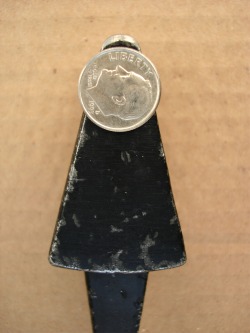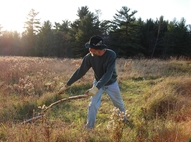 Modern wheat varieties have been developed for ease of growing and harvesting on a vast scale with machines, for disease-resistance in huge monocultures, and high gluten content for commercial bread baking. As with fruits and vegetables, flavor and nutrition have become a more minor consideration. If you are going to go to all the work of raising small grains by hand, you might want to consider getting involved with raising, and preserving, ancient and heritage varieties of grain, that were developed during the eras when they were grown on a small scale, and harvested by hand. There may be a wisdom to their development, that is lost at a modern machine scale. For example, very tall winter varieties can out-compete the weeds more easily. Also growing, and harvesting small-grains by hand, is an awful lot of work for something that you can easily buy in bulk at a natural foods co-op. A better niche for the scythe user, would be to grow rare heritage varieties, that you can't buy anywhere else. You can help preserve them for the future, and also adapt them to your bio-region. Start with a variety of different grains in garden-sized plots, and see what does well in your area. Save the seed of what grows, and tastes the best, to sow larger areas the next year.
12 Comments
 Yes. Besides keeping your blade really sharp, when mowing dense bluegrass, you have to make sure that the blade gets down underneath the grass blades, otherwise the scythe blade can slide up over the grass, like it's on top of carpeting, and not cut much. To keep the blade low, you can actually press down on the lower grip, which will keep the blade pressed firmly to the ground. You may be cutting the grass pretty short the first couple of times, but the regrowth will be more tender, and easier to mow. You will have to mow less often with a scythe, than with a lawnmower. Also, grass is always much easier to mow very early in the morning. Don't worry, your neighbors won't complain, even if you're out mowing at 6AM on a Sunday morning. Mow when the dew is still on the grass, and before photosynthesis gets going. It will be much less work that way.  A narrow, or bar peen anvil, needs to have a rounded face. How rounded should it be? Preferences vary with peening techniques. The amount of roundedness is called the radius. Since all rounded narrow anvils are rounded off by hand (not cast), it's an approximation that can vary slightly between individual anvils, and considerably with entire batches from year to year. The amount of radius makes a huge difference in how the anvils peens, yet no one that sells scythe anvils ever describes it. I've been trying for years to think of a way of classifying the amount of radius on a narrow anvil. Measuring the radius in actual mm is hard to relate to unless you're an engineer. Also, I don't have a metric radius gauge, and haven't come up with one yet. Classifying the radius as narrow, medium, or wide seemed too vague and relative, without a method of measurement. So I thought of comparing the radius to a common standard sized object. The best thing that I could think of was a U.S. dime, which has a radius of 9mm. According to engineer Gerhard Wagner of the SFX factory, a radius of 9-12mm on a narrow anvil is classified as a "blunt" anvil. 6-8mm is a "normal" anvil, and 4-5mm is a "sharp" anvil. The Picard anvil pictured above, looks like it has a radius at the narrower side of the "normal" spectrum. The commonly available Czech-made "babbka's", are not rounded, but they are soft enough to shape a radius to your liking. Good luck doing that with the Picard, or the 60 Rockwell SFX anvil! A team of 10 men with scythes versus a tractor-powered, sickle-bar mower. Each side mowed a 120 meter strip of tall grass. It looks like it was calculated to be an even match. Yes, the scythers win! By a scythe stroke. I wonder how many calories the 10 men burned, and how many oil-calories the machine burned?
Hi,
I have just taken on a smallholding and am learning to scythe the grass on some neglected pasture (thick grass, thatch, tussocks etc). I have found that after peening and honing the blade with reducing grades of whetstone, the blade is clearly sharp and “grabs” the grass and slices though everything with ease. After about ten yards, the blade is much blunter. I’ve then been trying to hone the blade with the Roszutec stone and, I’m finding that the scythe quickly loses it cutting ability compared to the initial treatment. I’ve been thinking about this and thought that there might be two reasons for this – either the edge was too thin to start with and I’m crushing it in the heavy vegetation. The other thought was that I wasn’t honing the blade properly each time with the fine whetstone, so it successively becomes blunter. I noticed on your farm website that: The Rozsutec whetstone is so fine and hard, that beginner's often can't get it to do anything. Once you learn how to really use a whetstone, however, it creates a very fine edge. And wondered if this was my problem. I also noted that, in your honing video (see above), you hold the stone in a way that would allow you to “torque” the stone onto the blade to apply fairly heavy pressure. I was hoping that you would be able to advise how much pressure should be applied when honing and whether you can offer any technique tips? Alternatively, would I be advised to try using a Bregenser stone initially for honing – or will this wear out the edge too quickly? Many thanks - Paul |
Botan AndersonArchives
March 2023
Categories
All
|

 RSS Feed
RSS Feed